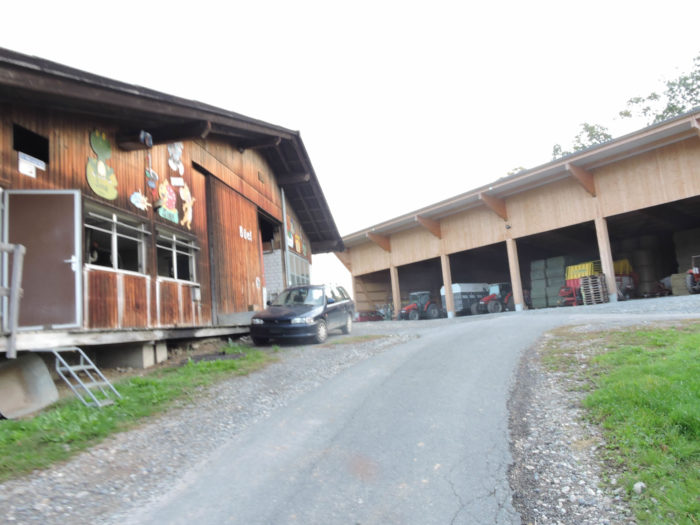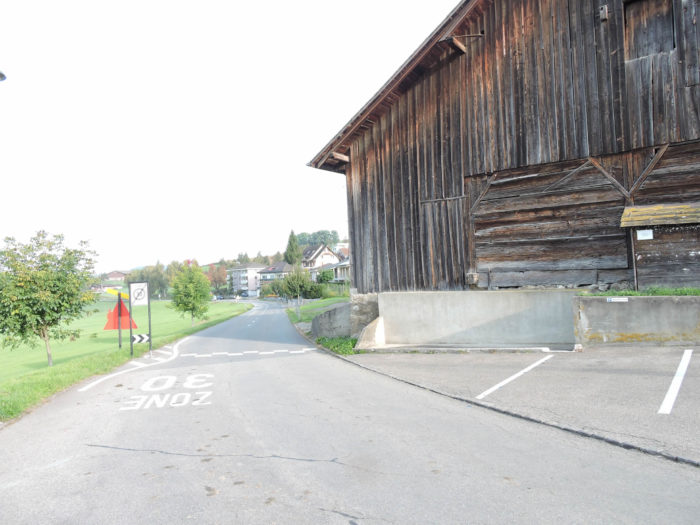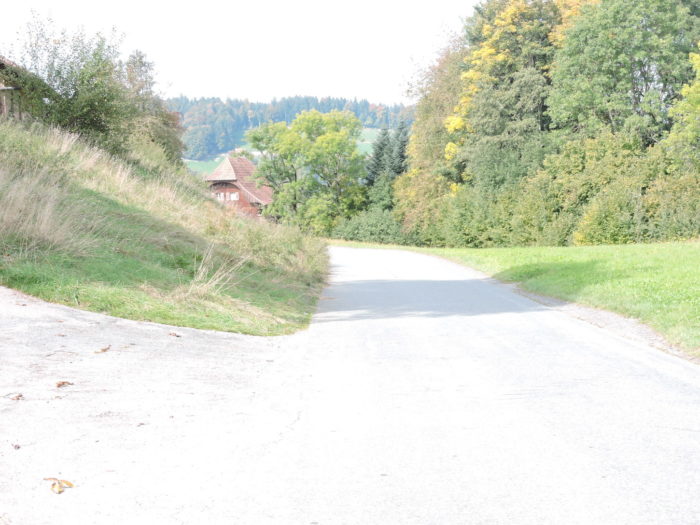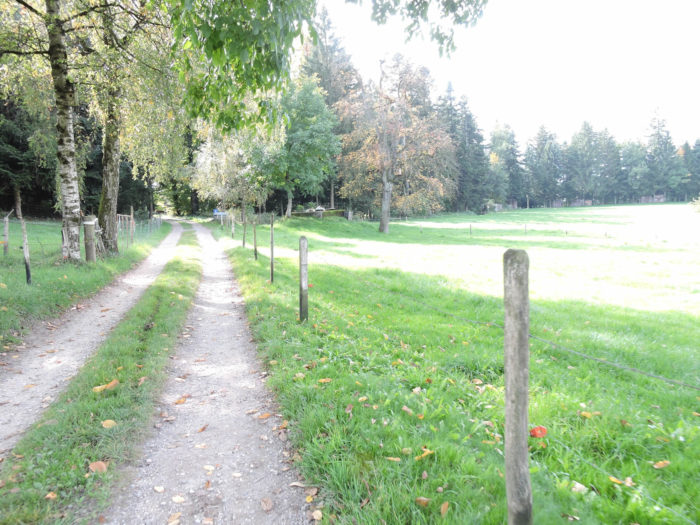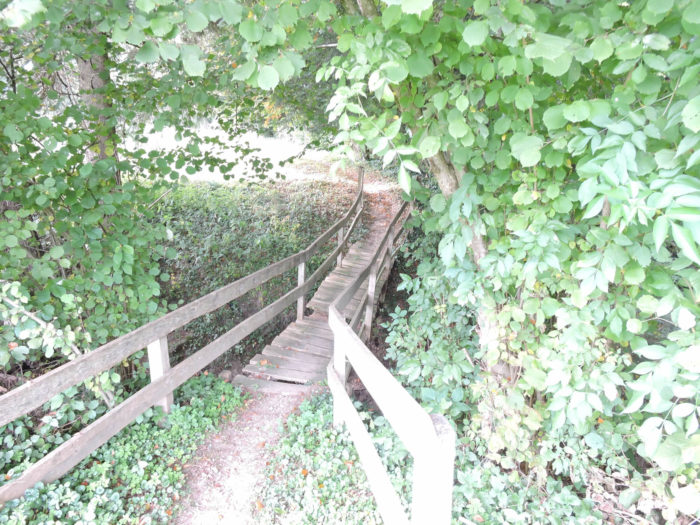A beautiful journey through the countryside of Luzern and Bern
DIDIER HEUMANN, ANDREAS PAPASAVVAS

We divided the course into several sections to make it easier to see. For each section, the maps show the course, the slopes found on the course, and the state of the route (paved or dirt roads). The courses were drawn on the « Wikilocs » platform. Today, it is no longer necessary to walk around with detailed maps in your pocket or bag. If you have a mobile phone or tablet, you can easily follow routes live.
For this stage, here is the link:
https://fr.wikiloc.com/itineraires-randonnee/de-werthenstein-a-huttwil-gare-par-la-via-jacobi-4-135850999
|
Not all pilgrims are necessarily comfortable using GPS or navigating routes on a mobile device, and there are still many areas without an internet connection. For this reason, you can find several books on Amazon dedicated to the major Via Jacobi 4 route, which runs through the heart of Switzerland and over the Brünig Pass. The first guide leads pilgrims through the German-speaking part of Switzerland up to Fribourg, while the second continues through French-speaking Switzerland to Geneva. We have also combined these two books into a compact, lighter, and highly practical version. While the descriptions have been slightly condensed, they remain detailed enough to guide you step by step along the way. Recognizing the importance of traveling light, this latest edition has been designed to provide only the essentials: clear and useful information, stage by stage, kilometer by kilometer. The stages have been carefully adjusted to ensure accessibility and alignment with available lodging options. These books go beyond simple practical advice. They guide you kilometer by kilometer, covering all the crucial aspects for seamless planning, ensuring that no unexpected surprises disrupt your journey. But these books are more than just practical guides. They offer a complete immersion into the enchanting atmosphere of the Camino. Prepare to experience the Camino de Santiago as a once-in-a-lifetime journey. Put on a good pair of walking shoes, and the path awaits you.
|

|
 |
If you only want to consult lodging of the stage, go directly to the bottom of the page.
Today’s route takes you from the peaceful Luzern countryside to the vast rural expanses of the Bern canton. At first glance, no radical change seems to occur in the landscape, but careful observation quickly reveals the subtleties that distinguish the Bernese countryside from that of Luzern. First, the farms, true symbols of local agriculture, exhibit a more vibrant and pronounced beauty in the Bern canton. While pig farming dominates in Luzern, Bern is ruled by the majestic presence of cows. The Bern canton stands out for its geographical diversity, offering varied landscapes that reflect the richness of its regions. Huttwil, the destination of this stage, is nestled in the Upper Argovia region, at the border between the cantons of Argovia and Solothurn.

In the heart of these lands, the Emmental reigns supreme, even though its true kingdom extends beyond, into the eponymous region just below. The French, incorrigible as they are— as everyone outside of France knows—claim many things, rightly or wrongly, including Emmental and Gruyère. However, these two cheeses are indeed Swiss, benefiting from a specific Appellation d’Origine Contrôlée (AOC). For a long time, Swiss cheese was referred to as « Gruyère » in France. The origin of this confusion lies in the similar characteristics between Emmental and the French « gruyère, » which also features holes. The mysteries of the holes in Emmental have finally been solved: tiny particles of hay, introduced during milking, release gases responsible for these cavities during the fermentation process. In Switzerland, the production area stretches from Zurich to Fribourg, while Gruyère is more associated with the French Fribourg region and parts of the Vaud canton. Although similar names are claimed in many countries, the true AOC is only valid in Switzerland. It is therefore tragic that some « Emmental » cheeses are not Swiss, being made in Germany, Austria, France, Finland, the Netherlands, and even America. But in the end, it doesn’t matter much! It’s still cheese.
It’s a very long stage. Some pilgrims will choose to split it in half, with an intermediate stop in the beautiful town of Willisau, resulting in two more manageable stages of 15 km each. Everyone at their own pace!

Difficulty level: The day’s elevation changes (+669 meters / -598 meters) are quite reasonable for a 30-kilometer stage. The first part of the route features a series of rolling landscapes before giving way to gentler plains approaching Willisau. After this stop, the route becomes steeper near the HirschPark (deer park), before transforming into a series of roller-coaster-like slopes, offering varied gradients to explore.
State of the Via Jacobi: Today, the route primarily unfolds on pathways, a perspective that can only delight walkers:
- Paved roads: 9.9 km
- Dirt roads : 19.8 km
Sometimes, for reasons of logistics or housing possibilities, these stages mix routes operated on different days, having passed several times on these routes. From then on, the skies, the rain, or the seasons can vary. But, generally this is not the case, and in fact this does not change the description of the course.
It is very difficult to specify with certainty the incline of the slopes, whatever the system you use.
For those seeking « true elevations » and enthusiasts of genuine altimetric challenges, carefully review the information on mileage at the beginning of the guide.

Section 1: In the countryside above Werthenstein

AGeneral overview of route’s difficulties: ups and downs with significant elevation changes.

In Werthenstein, where routes diverge like the destinies of souls in search, the Via Jacobi 4 and Via Jacobi 3 part ways, each bearing its unique imprint in the fabric of pilgrims’ or hikers’ stories. One must remember the special marking of the Camino de Santiago in Switzerland. On the Via Jacobi 4, the number 4 is framed by a blue rectangle, like a beacon guiding souls on their pilgrimage. The reverse, in its non-rectitude, remains without this bright blue symbol.

|
Like a breath of life, the road climbs above the sleeping village, intertwining its route with that of the railway line, like a fleeting dance, before getting lost in the meanders towards Willisau, like an adventurer eager for discoveries.
|
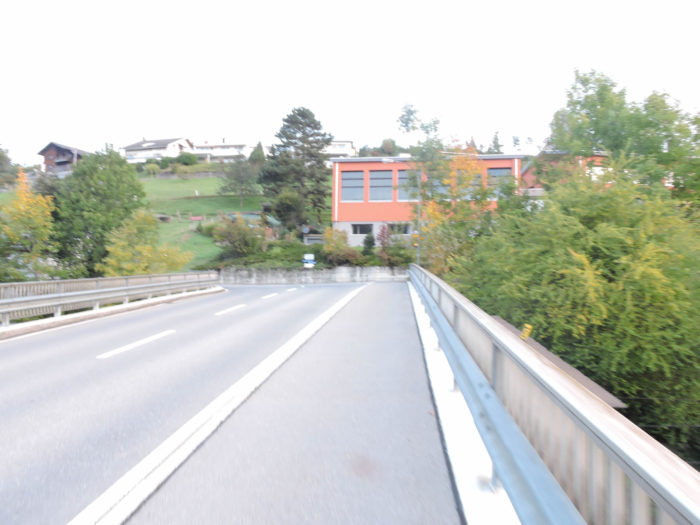 |
 |
|
The hairpin road inscribes itself in the landscape, drawing arabesques on the green canvas of the valley. On the other side, the convent emerges on the hill, like a silent guardian watching over wandering souls, a spiritual presence dominating the panorama with sacred majesty.
|
 |
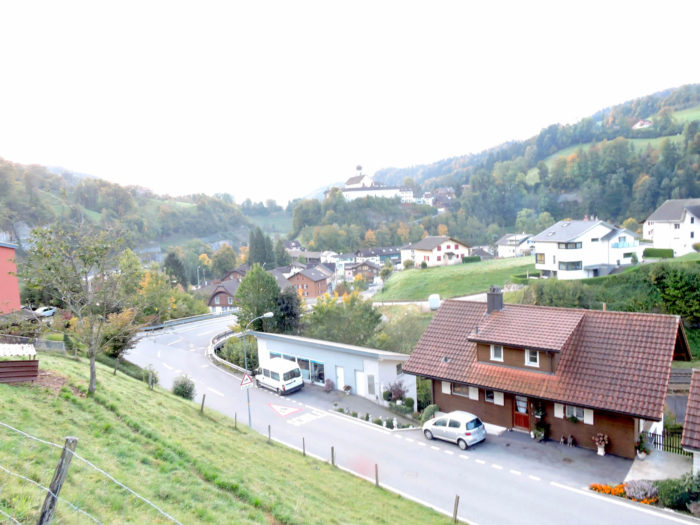 |
| A bit higher, a trail deviates from the main road, a secret way that climbs through the undergrowth. |
 |
 |
|
The trail, like a fragile scar in the fabric of the forest, gracefully winds through the undergrowth before emerging in the meadows on houses clinging to the hillside.
|
 |
 |
A path, true to its nature, like a silver thread woven into the landscape, quickly joins the road near the small houses of Grofehuse, on the outskirts of Werthenstein, like a traveler finding their bearings in a familiar world.
|
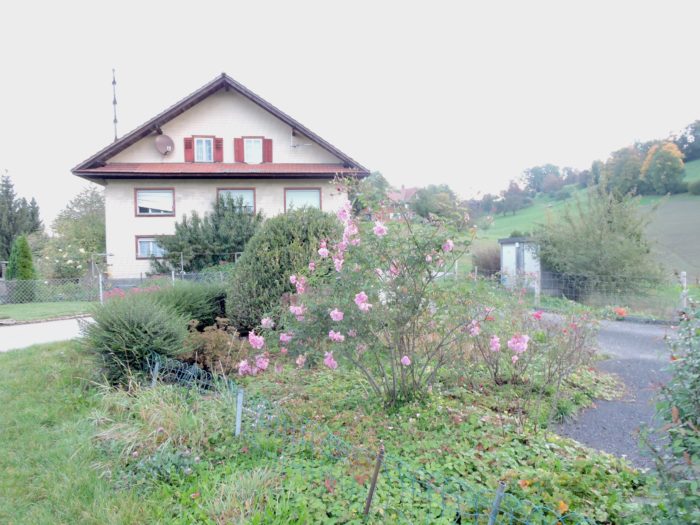 |
 |
| These places exude authenticity, adorned with beautiful wooden houses, perhaps former flourishing farms. Their elegant eaves, typical of Bernese homes, testify to an architectural heritage that transcends cantonal borders, even though you still remain in Luzern territory. |
 |
 |
| The road, like a tranquil stream, unfolds before a discreet oratory, a sanctuary of piety nestled in the hills, before gently rising through the countryside, where the green meadows seem to gaze over the fields with a benevolent eye, like a symphony of colors and textures, in the grand theater of nature. |
 |
 |
| Further on, the route, like an insatiable adventurer, leaves the road to delve into the green meadows and cross the Bielbach stream, like a graceful dancer crossing a stream to reach the other bank. At the bottom of the dale, nestles the discreet hamlet of Bielmülli, like a hidden treasure in the bosom of nature, its modest farms seemingly watching over the landscape with serenity. |
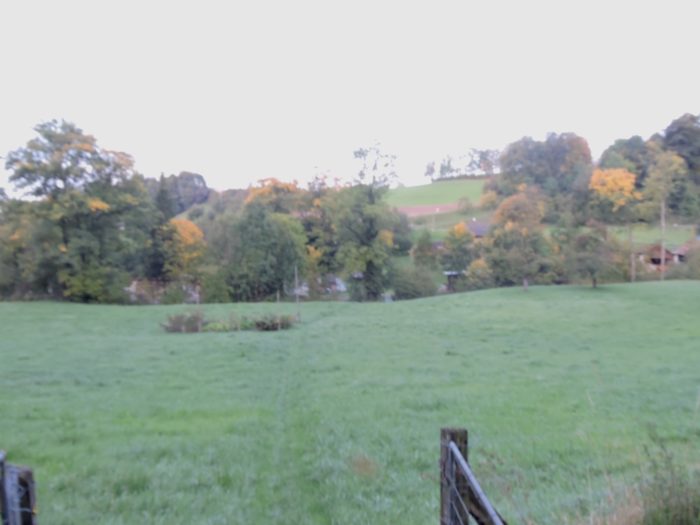 |
 |
| A modest road slopes up from the hamlet, like a way traced by ancestors, crossing a more imposing artery before climbing towards the hamlet of Büel, passing near a majestic farm that breathes the authenticity of the countryside. In the surrounding meadows, the elegant silhouette of Simmental cows gradually appears, replacing the grey and Braunvieh cows of eastern Switzerland, like a harmonious transition between two worlds, as if each region unveiled its own palette of colors and flavors. |
 |
 |
| It is customary in this region to also raise pigs, a tradition rooted in the fertile lands of the Luzern countryside, where each animal seems to be a centerpiece of the rural puzzle. Shortly after, like a traveler eager to continue their journey, the Via Jacobi leaves the farms, its steps echoing on the pavement. |
 |
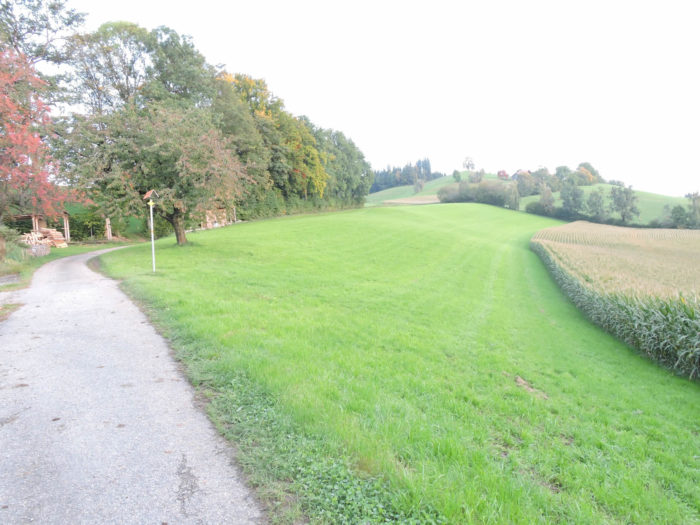 |
| Further on, it is a dirt path that winds gently through the countryside, like a ribbon of clay caressing the fertile earth, punctuated here and there by modest groves of oaks and beeches, sometimes trees gently swaying in the breeze. In German-speaking Switzerland, the meadows spread out their bright green, an almost unreal color, like a blessing of nature. |
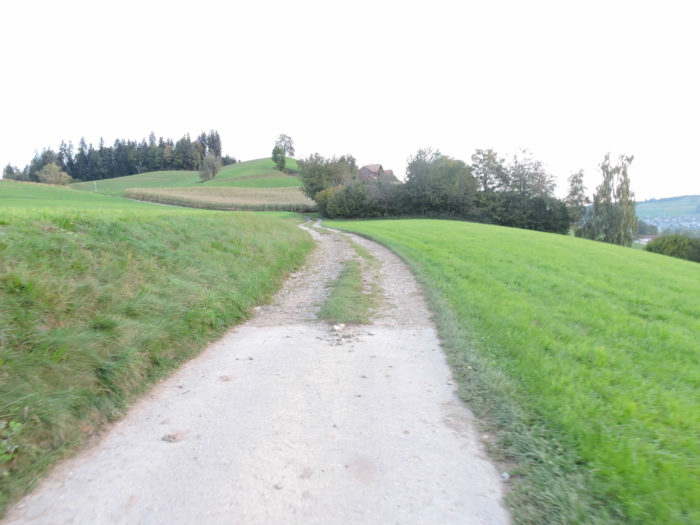 |
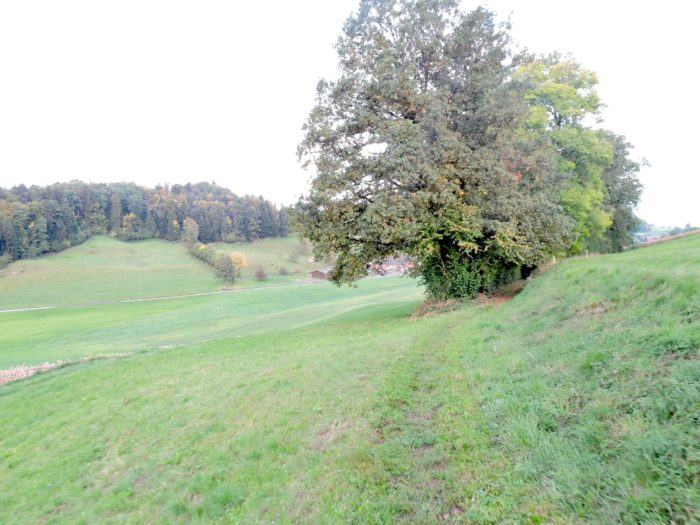 |
Your course is set for Willisau, through the Via Jacobi 4, a route dotted with religious signs marking the roads like prayers whispered to the wind.

| The path mainly winds through the meadows, rarely making its way through the undergrowth. All around, stand farms, whether isolated or grouped in modest hamlets. The organization of farming mainly unfolds in an isolated manner, with the lands surrounding the estates, rarely integrated into compact villages, like pieces of a rural puzzle that fit together harmoniously. |
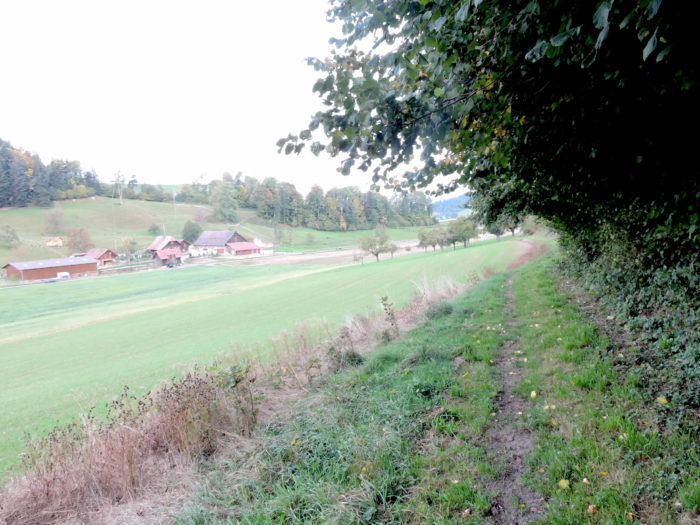 |
 |
| The path quite longly traverses the hillside, where you will also encounter modest fruit trees, like discreet guardians of forgotten orchards. |
 |
 |
| Further on, it heads to a small chapel, its delicate silhouette outlined under a majestic weeping birch, like a sanctuary of peace in the heart of nature. |
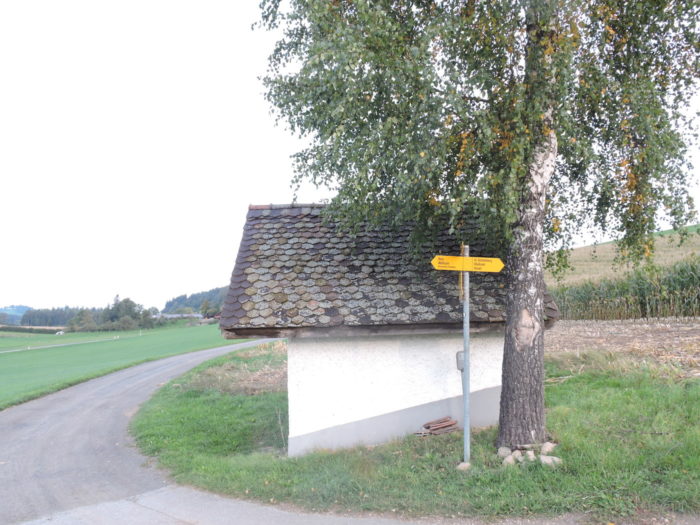 |
 |
| At the end of the hill, the Via Jacobi 4 reaches the tarmac in the village of Buholz, where trophies won in agricultural competitions hang, silent witnesses to the ardor of Swiss farmers. Switzerland is above all a country of men and women of the land, whose hands are shaped by the hard work of the fields. |
 |
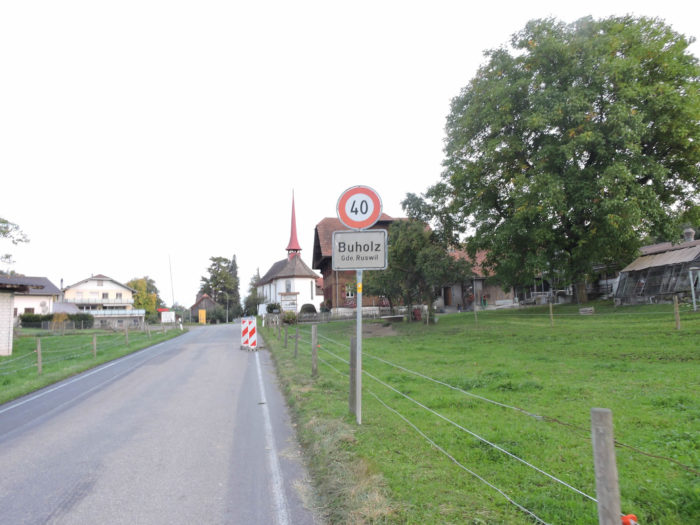 |
The signpost, like a benevolent guide, indicates the direction of Geiss. Willisau, still two and a half hours from here, seems like a distant dream, a destination to conquer step by step, through fields and hills.

| The Via Jacobi 4 leaves Buholz on the tarmac but quickly merges into a dirt path, climbing ardently between undergrowth and countryside, like an adventurer eager to discover the hidden mysteries behind every grove and every valley. |
 |
 |
Section 2: In the Luzern countryside along Luzern farms

General overview of route’s challenges: ups and downs with generally reasonable elevation changes.

The slope becomes steep in the small forest of Galgebergwald, where majestic hardwoods dominate, their branches stretching towards the sky like fingers eager to touch the stars. Here, you will discover the well-ordered rigor of German-speaking Switzerland, with a path dedicated to riders and another for walkers, a meticulous organization reflecting the methodical soul of this country.

| After a brief interlude in the heart of the woods, the path emerges again in the meadows, near the tiny lake of Soppisee, like a hidden gem within nature, its calm waters reflecting the sky like a mirror of the soul. |
 |
 |
| On the horizon, near Menznau, stand the smokestacks of two towers, evoking familiar images of nuclear power plants. But do not be mistaken, for these are not the towers of a nuclear power plant, although three of them are located further away, with the Gösgen plant being the closest, about thirty kilometers from here. |
 |
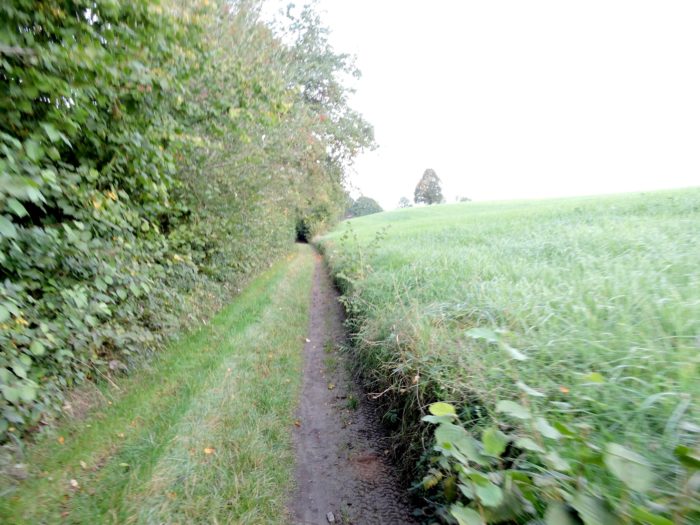 |
| The path crosses one of those charming picnic areas once again, carefully arranged to welcome Sunday strollers. Ultimately, only the sausages are missing to perfect this idyllic scene, an invitation to relaxation and conviviality in the heart of nature. |
 |
 |
| The farmers engage in an odorous activity that the French-speaking Swiss call « purinage, » a term evocative of the raw reality of agricultural life. The smokestacks on the horizon also belong to the Kronospan Schweiz SA company, a large enterprise founded in 1966 with nearly 450 employees. This company, specialized in the manufacturing of particle board and laminate flooring, was the scene of a tragedy a few years ago. One of its employees opened fire on his colleagues, killing four and injuring several others in the cafeteria and corridors of the factory. The toll was heavy: five dead, including the perpetrator of these senseless acts. |
 |
 |
| Further on, the path approaches the hamlet of Hügihof, where the countryside stretches magnificently as far as the eye can see, like a true postcard of the fields, where each blade of grass seems to be painted by the hand of an inspired artist. |
 |
 |
| At the end of the meadows, like a traveler returning to civilization, the Via Jacobi 4 reconnects with the road that winds towards Geiss, bordered by majestic oaks and ash trees, their branches stretching towards the sky like welcoming arms. |
 |
 |
| It then crosses the village, with its century-old church, a few bourgeois houses with elegant facades, and numerous scattered farms, silent witnesses of a still vibrant rural past. |
 |
 |
| Further on, the road heads towards Eiswil, thirty minutes from Menznau, delving into a landscape dotted with farms and splendid wooden bourgeois houses, like jewels scattered in a green setting. The smokestacks of the nearby sawmill persist in the landscape. |
 |
 |
| In Eiswil, a fork offers the opportunity to reach Menznau, a valuable alternative for those who did not find shelter in Werthenstein. The Via Jacobi 4 does not take this direction and continues on the main road. In this hamlet, the very essence of life is agricultural, with fields stretching as far as the eye can see and wooden homes standing like jewels lost in the heart of nature, whose beauty has probably changed little over the centuries. |
 |
 |
| From Eiswil, the Via Jacobi 4 continues along the road until reaching the Oberstudeweid fork. The landscape remains unchanged, with vast meadows still stretching out punctuated by a few crops, where farms blend harmoniously into the surrounding nature. |
 |
 |
| Further on, it again escapes into the grasses of the meadows, like an insatiable traveler seeking to explore every corner of this generous land. |
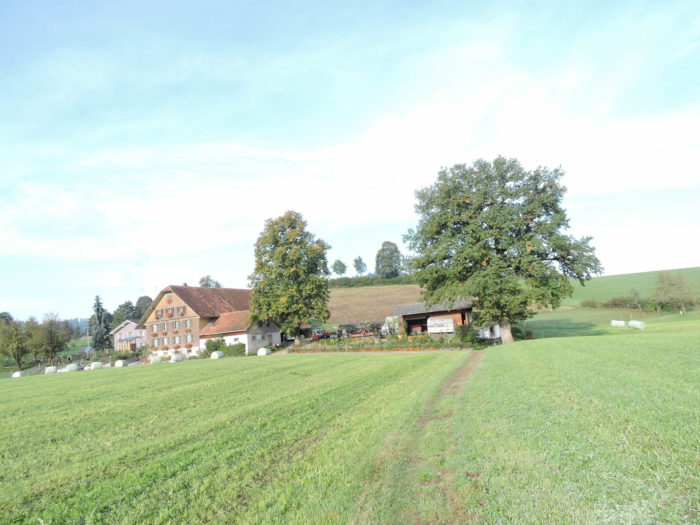 |
 |
|
Here, the landscape is sometimes adorned with hedges of corn scattered in the meadows, adding a touch of color to this rural canvas. Despite the passing time, the smokestacks of the wood factory continue to mark the horizon.
|
 |
 |
Section 3: Ever more in the magnificent Luzern countryside

General overview of route’s challenges: an easy route, except for a steep descent towards the end of the segment.

|
The path meanders for a long time along the sides of small rounded hills, like a ribbon undulating through green meadows or along corn hedges, dotted here and there with magnificent pedunculate oaks, their branches stretched out like welcoming arms.
|
 |
 |
Further on, it approaches the imposing farms of Baldhut, powerfully emanating the invigorating scent of the countryside, like solid bastions in the heart of nature.
|
 |
 |
| As the route continues, the tarmac gradually replaces the dirt road, and the Via Jacobi heads towards the neighboring hamlet of Schwand. The farmers, always imbued with their legendary pride, proudly display their war trophies on the facades of their farms, symbols of their livestock and their attachment to the land. |
 |
 |
| Behind the last scattered farms of the hamlet, the path resumes its course in the soft grass, gradually delving into the undergrowth, like an adventurer rediscovering the peaceful silence of deeper nature. |
 |
 |
| From this point, the gentle hills give way to more rugged and wild landscapes, where the path delves into more uneven and wild scenery. |
 |
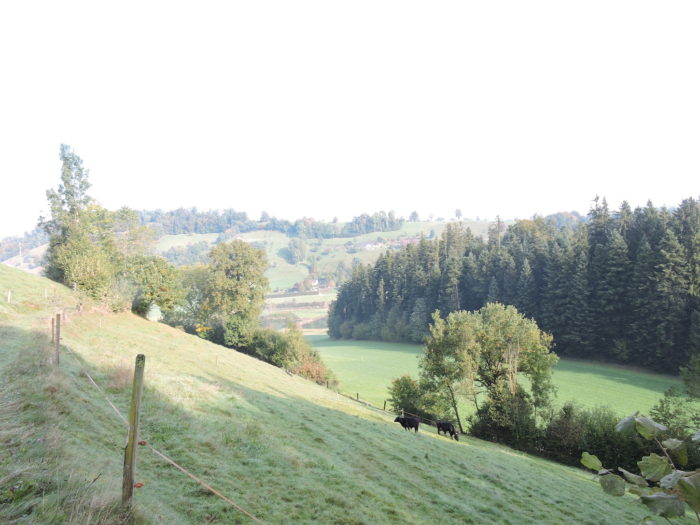 |
| It even requires a few impromptu acrobatics through a trail in the meadows, skillfully juggling between fences to bypass a farm that stands in its way, like an unexpected obstacle. |
 |
 |
| Behind the curtain of greenery of the forest, nestled in the valley, appears Willisau, like a jewel nestled in the surrounding nature. Below, the Ostergau ponds come into view, towards which the trailh descends abruptly, like a daring diver plunging into deep waters. |
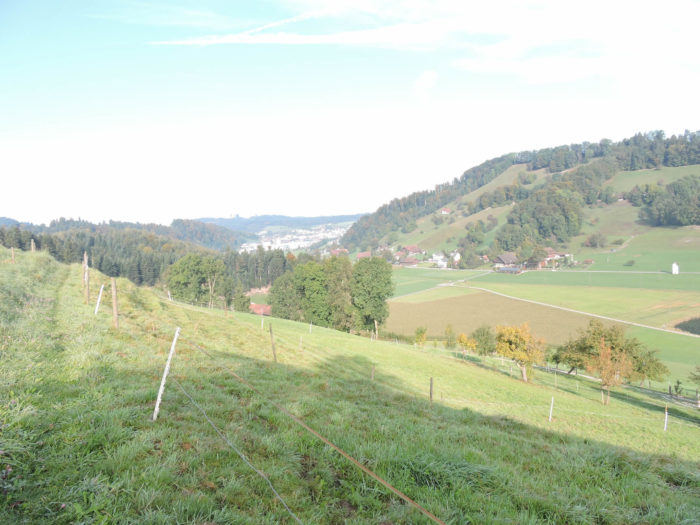 |
 |
| At the foot of the descent, on the wooden logs that resonate under each step, the trail joins a modest road winding towards the hamlet of Ostergau-Hinterwald, where the farms are more closely grouped. |
 |
 |
| The farms in the region are of singular beauty, with their sloping roofs and awnings resembling caps. The countryside here is gentle, serene, imbued with a soothing tranquility. In Switzerland, a country with limited territory, walking usually takes place through densely populated farming areas, less often in the woods. The vast forests are generally located at higher altitudes, where the Camino de Santiago seldom ventures. |
 |
 |
| At the exit of Hinterwald, faithful to its intent to keep pilgrims away from roads, even the most modest ones, the Via Jacobi 4 always reveals an alternative solution to bring you back to the cornfields and wooded paths. |
 |
 |
| And so here are the vast cornfields, the tall grass brushing against shoes and socks, adding a touch of freshness to each step, before gently sloping up towards a mysterious undergrowth, where the shade of the trees welcomes you into a haven of peace. |
 |
 |
| At the exit of the woods, the route regains the soft touch of grass underfoot, crossing the vast plain of Willisau, where the slender Seewag stream meanders gracefully. |
 |
 |
| Then, the grass gives way to tarmac as the Via Jacobi 4 heads towards the hamlet of Länghus, crossing another small stream, the Rot, like a silver thread winding through the green meadows. |
 |
 |
| Oh, what a magnificent farm, offering its flowered facade under its beautiful awning to the astonished gaze! Who dares to claim that beautiful farms are only in the canton of Bern? There are many gems scattered throughout German-speaking Switzerland, testifying to the timeless beauty of rural life. Unfortunately, they are less present in French-speaking Switzerland. |
 |
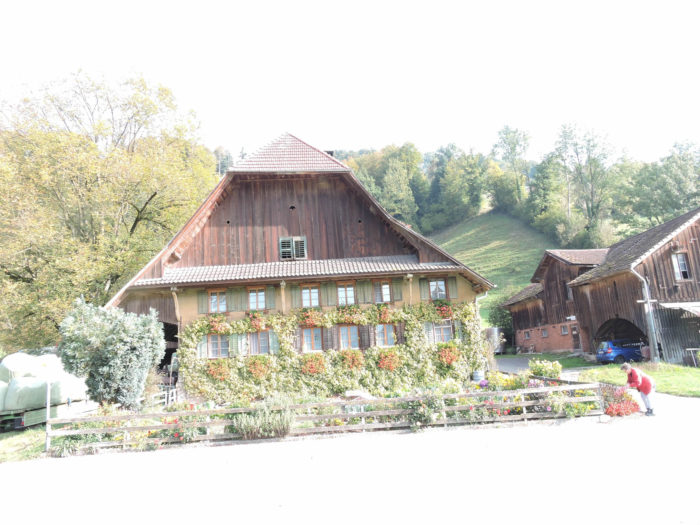 |
Section 4: Passing through the beautiful town of Willisau

General overview of route’s challenges: an easy route, except for a steep climb in the Hirschpark and forest.

| Shortly after, the Via Jacobi travels a few hundred meters on a somewhat busy road, where the noise of vehicles contrasts with the surrounding rural calm. |
 |
 |
| Then, it makes a sharp right turn to follow the winding course of the Seewag, thus regaining the comfort of the dirt path underfoot. |
 |
 |
| It then follows the stream through the vast industrial area of Willisau, flanked by a wide hedge of deciduous trees. In this environment where human activity buzzes, large, gleaming enterprises flourish, ranging from logistics to distilleries, like flowers in an urban garden. |
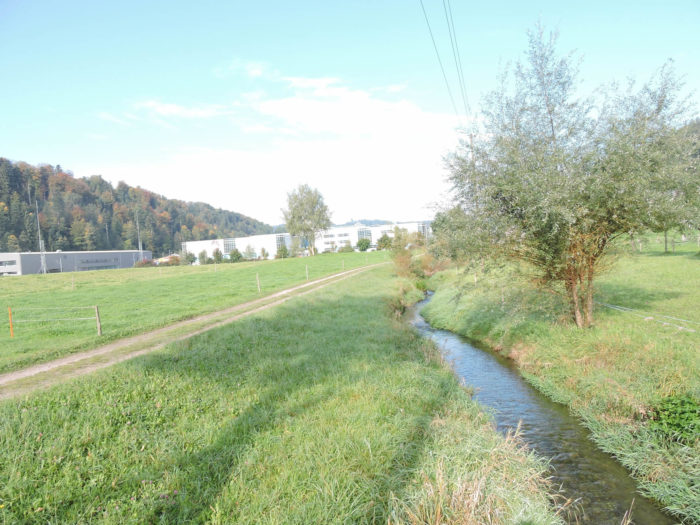 |
 |
| The traverse of the industrial area proves quite lengthy, reflecting the significant economic activity in this region. |
 |
 |
| At the end of this industrial zone, the path reaches a junction at the town’s entrance, where it passes under the RN2a road. This place is teeming with bike paths, offering multiple options for local cyclists. |
 |
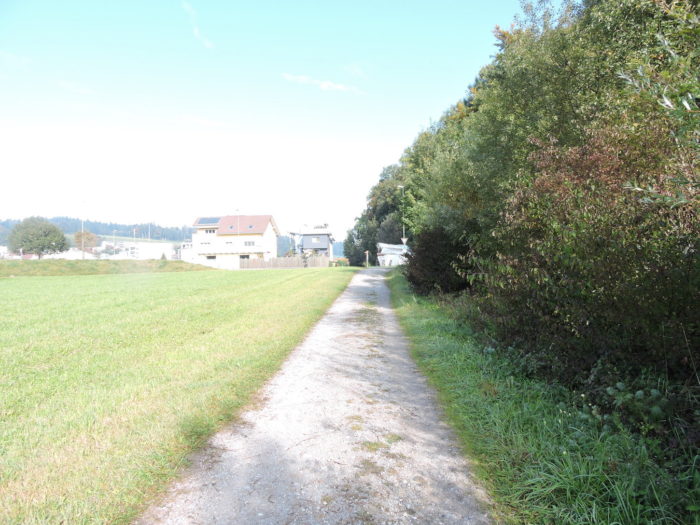 |
| Shortly after, the road passes near a large wood impregnation factory before heading towards the station, heralding the return to urban civilization. |
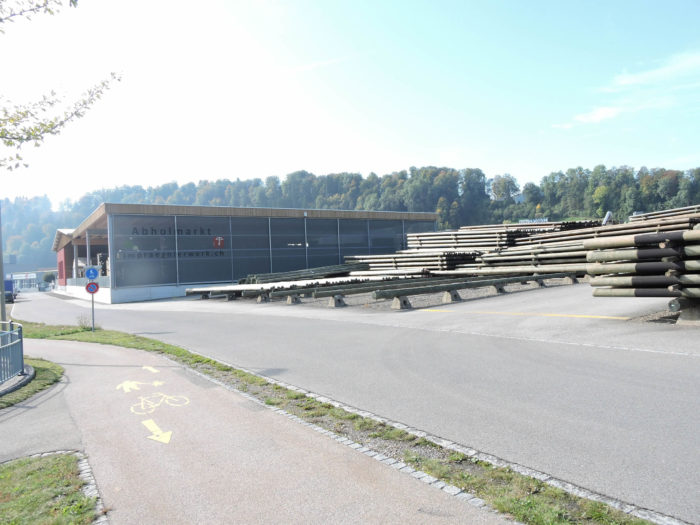 |
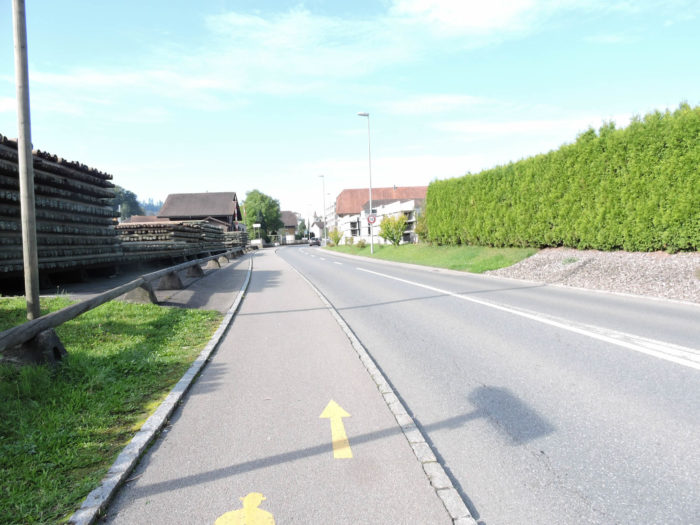 |
| It then passes near the station, where the main lines connecting Luzern and Bern intersect, witnesses to the incessant flow of travelers and railway activity. |
 |
 |
| Next, the Via Jacobi continues from the station towards the vibrant heart of the city center, where the pulse of the city beats. |
 |
 |

| Willisau, with its 7,800 inhabitants, presents itself as the little sister of Murten. It boasts a similar layout, with a rectangular heart sometimes encircled by walls. Despite the trials it has faced, including the devastating fires of 1471 and 1704, the town has risen from its ashes and today offers a remarkable urban landscape, where each house seems to vie for solidity and beauty. |
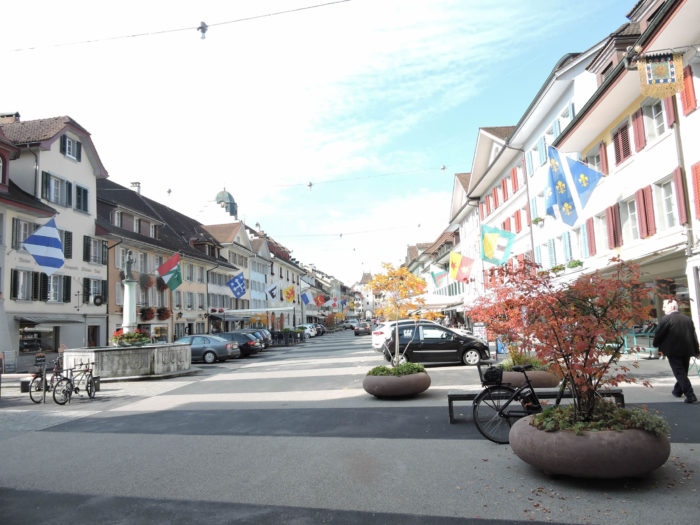 |
 |
| The Rathaus, though modest, blends harmoniously into this urban decor, where signs and flags contribute to creating an atmosphere of great harmony. Despite its architectural richness, due to its geographical position, Willisau remains relatively sparsely visited by tourists, thus preserving its authenticity. |
 |
 |
| Throughout the ages, many churches have adorned the landscape of Willisau. Only one Romanesque tower remains today, while the Baroque church of St. Peter and Paul, built at the beginning of the 19th century, testifies to the city’s spiritual richness. |
 |
 |
|
In this peaceful and elegant town, as the Via Jacobi gently moves away from the city center, it encounters another church, that of the « Blood of Christ, » offering a last glance at the spiritual diversity of this charming city.
|
 |
 |
The Via Jacobi then heads towards Hirsch Park, this haven of peace where deer reign, but do not be mistaken, Huttwil is still more than four hours of walking away, as announced in the preamble of this long stage.

| Near a mobile library, the path crosses the Einziwigger, a watercourse that is nothing more than a large, peaceful stream. |
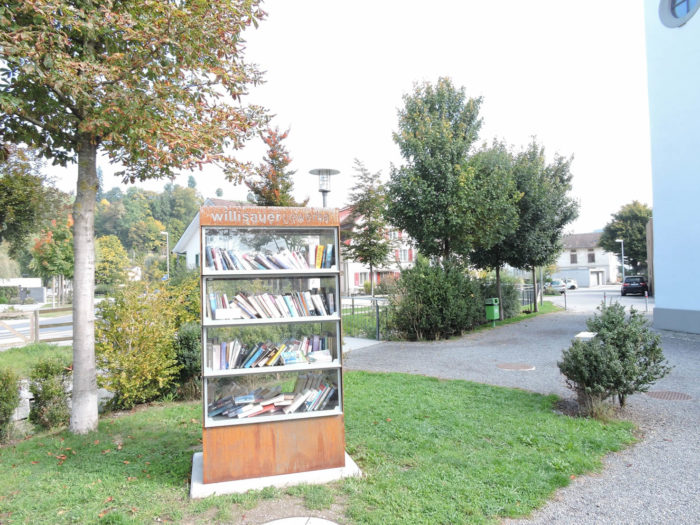 |
 |
Beyond the cemetery, a small tarmac path climbs in a steep slope on the hill towards Hirsch Park, thus offering a marked ascent towards this sanctuary of nature.
|
 |
 |
Modest stairs guide the walkers higher in the park…
|
 |
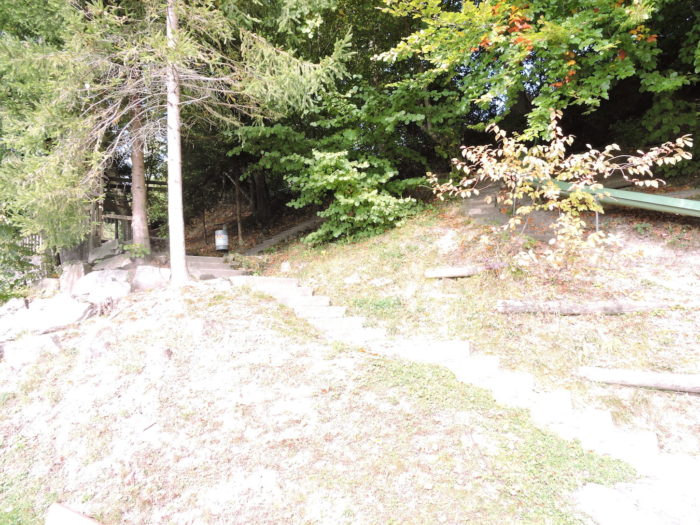 |
| …where a few deer, peaceful and curious, observe the passing visitors without suspicion, languishing in the grass. |
 |
 |
| A narrow and steep trail then briefly climbs above the park, protected by fences, leading the walkers to an imposing and austere cross that silently watches over the town, like a benevolent guardian. |
 |
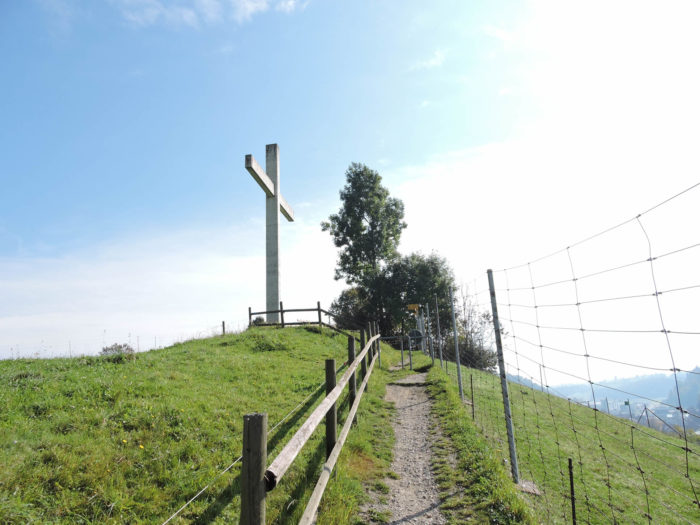 |
| From the summit where the cross stands, the Via Jacobi prepares to leave the civilized world for many kilometers through wild and preserved lands. It gradually delves into the green meadows, approaching the edges of the forest where majestic Simmental cows seem to greet you with a graceful bow. Alongside the woods, populated with spruces, beeches, a few oaks, and scattered maples, it traces its path. |
 |
 |
From this spot, an impressive view of Willisau unfolds before your eyes, like a living painting spread at your feet, inviting you to contemplate the harmony between nature and man.

| A newly opened path on the occasion of Willisau’s 700th anniversary, the Jubiläumsweg, guides you through the Chällerhölzli forest, where straight beeches stand like sticks, forming a veritable botanical collection. At the beginning of this forest, diversity reigns with a harmonious mix between deciduous and coniferous trees, each standing with a presence worthy of ship masts. The atmosphere here is simply magical, transporting walkers to a world of enchantment. |
 |
 |
At the place known as Willbrig, the landscape transforms. In this Hölzli (small wood), where the locals embody modesty, you will find some of the tallest conifers in the country. It takes the curiosity of the most knowledgeable botanists and lumberjacks to determine whether they are silver firs or Oregon pines, also known as Douglas firs, or perhaps both.

| In any case, these imposing trees exhibit their height and majesty, with bare trunks and leafy tops rising more than 40 to 50 meters above the ground, sometimes overshadowing the modest spruces, oaks, and beeches alongside them. |
 |
 |
| The forest, although remarkably beautiful, is also a place of intense economic activity, as is often the case in this region. The loggers take a well-deserved break near a small cabin. |
 |
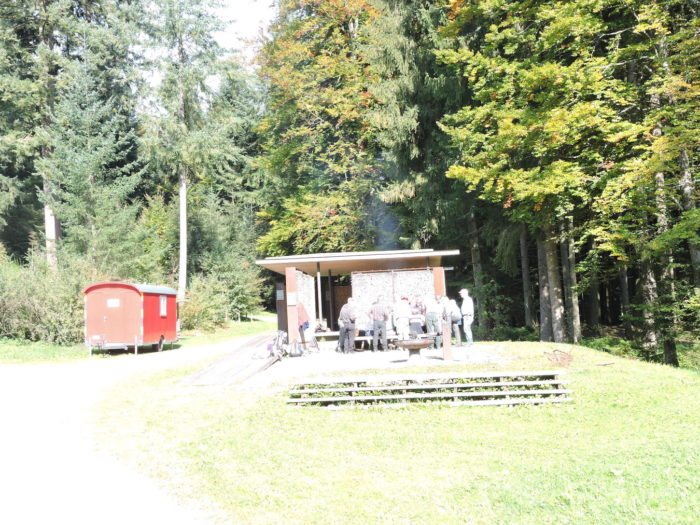 |
Section 5: Between meadows, farms, and forests

Between meadows, farms, and forests: hilly terrain, but without major difficulties.

| A wide path then opens through a prestigious forest, where large conifers, such as spruces or Douglas firs, dominate, often bearing witness to the loggers’ cuts and lying in sad shreds on the ground. |
 |
 |
| Shortly after, the path leaves the woods to venture into the meadows, near the farms of Schwarzwald, immersing the walkers in a gentle countryside where an atmosphere of tranquility and well-being prevails. Here, everything seems to breathe life, from wood piles waiting to be used to geraniums blooming joyfully in the windows of the farms, to garden gnomes mischievously punctuating the gardens. |
 |
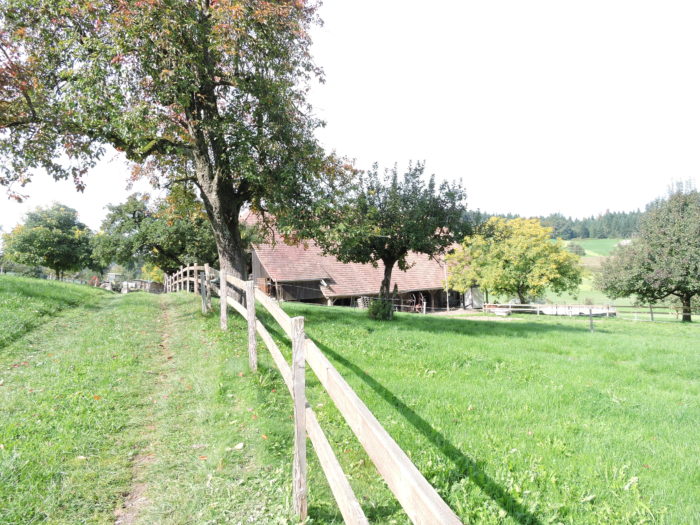 |
| Further on, a narrow-paved road winds through the meadows, offering a view of a resplendent countryside, towards the three small hamlets of Olisrüti. In this picturesque region, pig farming is a deeply rooted tradition, reflecting the character of the local farmers. If one of them decides one day to plant tomatoes, the others will invariably follow. Not that tomatoes grow better here, but simply out of a desire to rival or even surpass their peers. |
 |
 |
| Between dirt path and paved road, the Via Jacobi crosses these modest hamlets where the houses sometimes seem to rise towards the sky, thus testifying to the ingenuity and creativity of the builders. |
 |
 |
| At the exit of Olisrüti, a wide path, sometimes paved with stones, unfolds at the edge of the Howald Forest, offering a walk in harmony with the surrounding nature. |
 |
 |
Further on, an imposing cross adorned with symbols marks the entrance to an undergrowth, inviting pilgrims to continue their journey through this spiritually charged atmosphere.

| The Via Jacobi then crosses the forest, where the trees become more modest in size and the vegetation grows more diverse. The forest path unfolds like a wide avenue, making the pilgrims’ journey smoother and easier. |
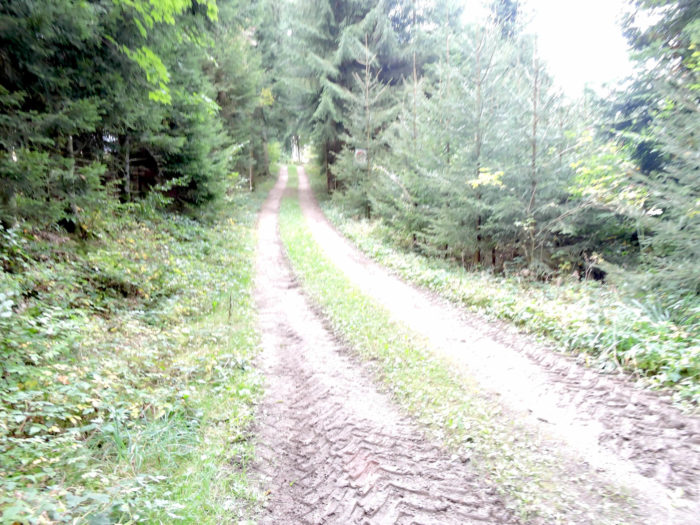 |
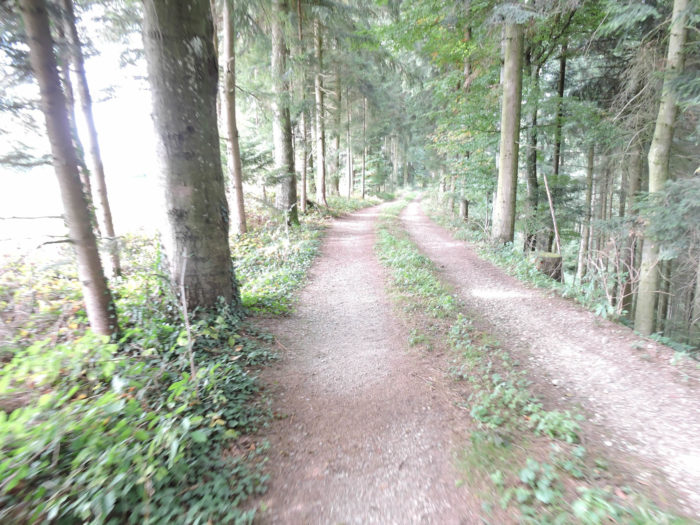 |
| Further on, the path briefly ventures into the surrounding cornfields and meadows… |
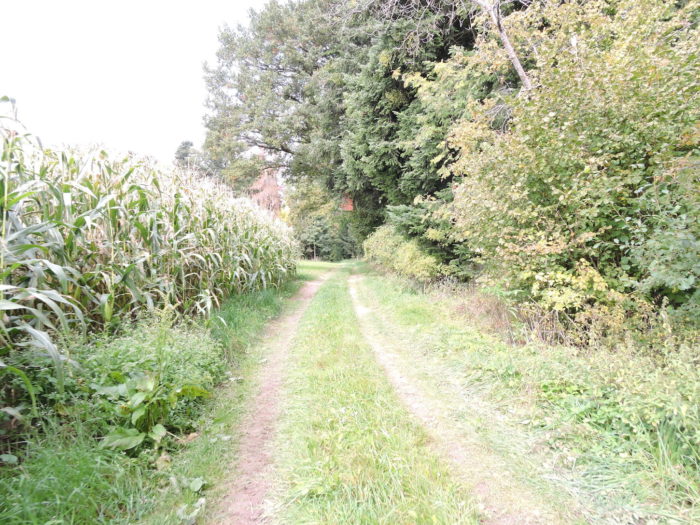 |
 |
| …before diving back into dense vegetation, this time on a more winding, more forested, and noticeably steeper trail. |
 |
 |
|
At the exit of the Hohwald Forest, the Via Jacobi plunges into the grass along the woods, exploring a small valley wedged between a green embankment and the foliage of trees.
|
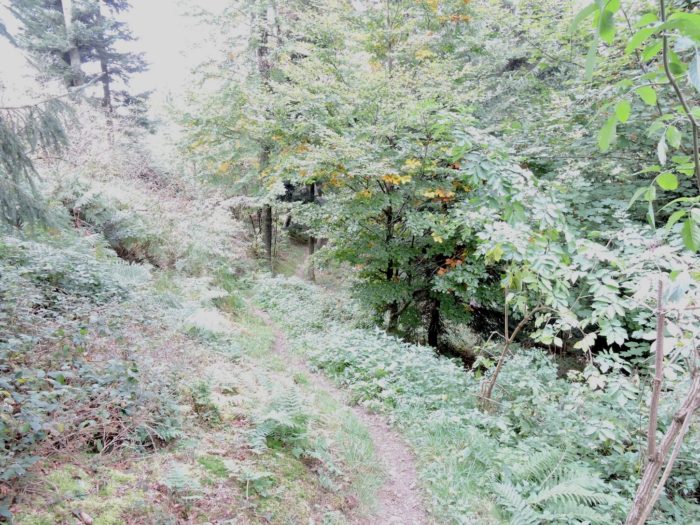 |
 |
|
At the bottom of the dale, the path climbs steeply, sometimes defying gravity to the point that even sheep struggle to keep their balance on their legs.
|
 |
 |
Section 6: Of small hamlets and little rivers

General overview of route’s challenges: hilly route, but without major difficulty.

|
Higher up, the slope softens, and the path crosses once again the vast meadows and fields, this time near the hamlet of Stocki, in a countryside with great openness, offering hikers a beautiful panorama.
|
 |
 |
You now have another two and a half hours of walking to reach Huttwil, a prospect that does not scare adventurous souls.

|
The path then stretches in a nearly flat line through the fertile fields, offering walkers complete immersion in the surrounding countryside. Here, the cultivated fields are less discreet than the vast meadows, a characteristic aspect of the region and even of Switzerland as a whole, where meadows clearly dominate the landscape.
|
 |
 |
Calm and serenity permeate these places, nestled in a delightfully rolling and harmonious landscape. A couple of hikers has chosen this idyllic spot to contemplate the majesty of the Luzern countryside.
|
 |
 |
The path then reveals itself in front of the modest houses of Im Bernet, where the Via Jacobi reconnects with the paved road and starts a gentle ascent through the meadows towards Hegihof.
|
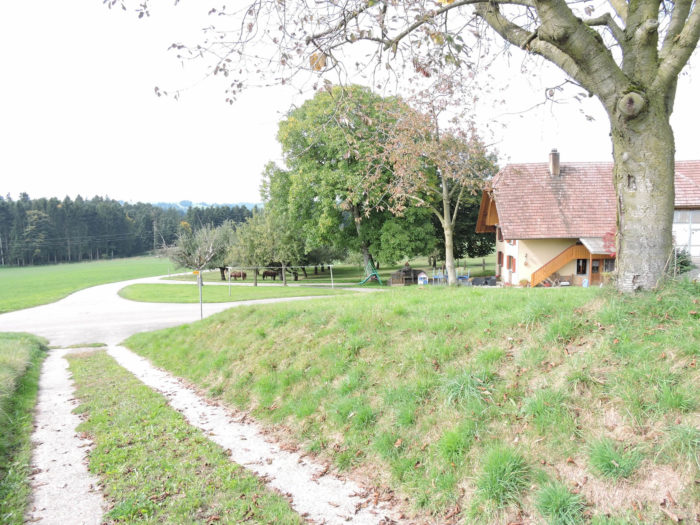 |
 |
At Hegihof, admiration for the grey cows of eastern Switzerland still persists, as they frolic freely in the green expanses of grass, embodying the rustic beauty of the region, a total symbiosis between livestock and their environment.
|
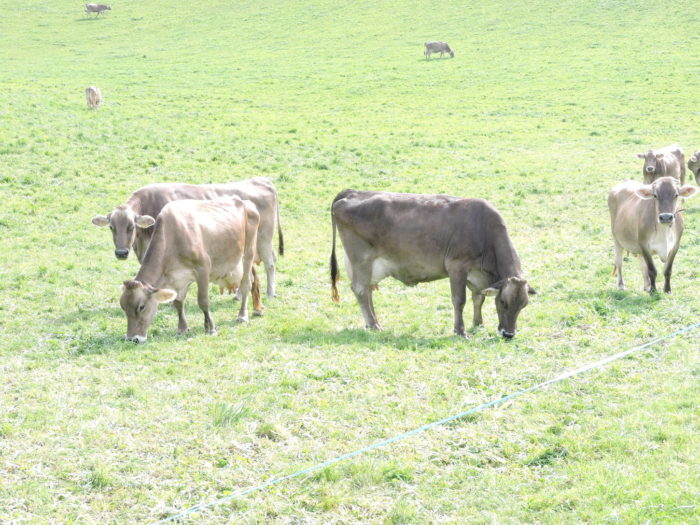 |
 |
Here, in these places where you become aware of the distances that still separate you from Santiago, the urge to quicken your pace becomes palpable.

| Once, this place may have hosted a shelter for pilgrims. But now, nothing remains. Perhaps the footsteps of travelers still echo here, and the land continues to welcome weary wanderers in search of rest and comfort. |
 |
 |
| The paved road then stretches towards the majestic farms of Oberwil, nestled in the heart of a generous countryside, where cows and sheep graze peacefully. In these Swiss regions, the White Alpine Sheep and the Black-Brown Sheep of the country reign supreme over the green expanses. |
 |
 |
| At the edge of the hamlet, near a pigsty, the Via Jacobi returns to the dirt road, winding from farm to farm. |
 |
 |
| Under the shade of lime trees and fruit trees, the dirt road sneaks back towards the forest edges, crossing a countryside shimmering with light. Much of the journey through German-speaking Switzerland takes place between groves and meadows, imbuing the voyage with a bucolic charm unique to these semi-open landscapes. |
 |
 |
| Once swallowed by the canopy, the path twists through a sunken trail, almost evoking the legendary exploits of William Tell, before soon reemerging onto a dirt road in the pastures. |
 |
 |
| A few steps further, the Via Jacobi crosses the lively waters of the Luthern, a substantial river babbling joyfully at the forest’s edge, punctuating the journey with an enchanting natural symphony. |
 |
 |
| On the other side of the bridge, the splendid farms of Schachenhof rise majestically. As one approaches the canton of Bern, the beauty of these farms becomes even more striking. Their roofs seem to nearly touch the ground, while their extended eaves give them an even grander and more elegant appearance. |
 |
 |
| The Via Jacobi continues its way along the paved road, winding between farms, towards Stoos. |
 |
 |
Only 30 minutes away from Ufhusen, and 1 hour 50 minutes from Huttwil, the upcoming arrival is a delightful prospect after such a long journey.

| The Via Jacobi continues through the gravel pit of Hiswil, unfolding peacefully along a small road that extends in the plain. |
 |
 |
| However, on the Way of St. James, moments of tranquility are fleeting. An imminent fork looms on the horizon, and it is crucial not to miss it. You will then have to face a steep climb through the meadows, with an incline that can exceed 20%. |
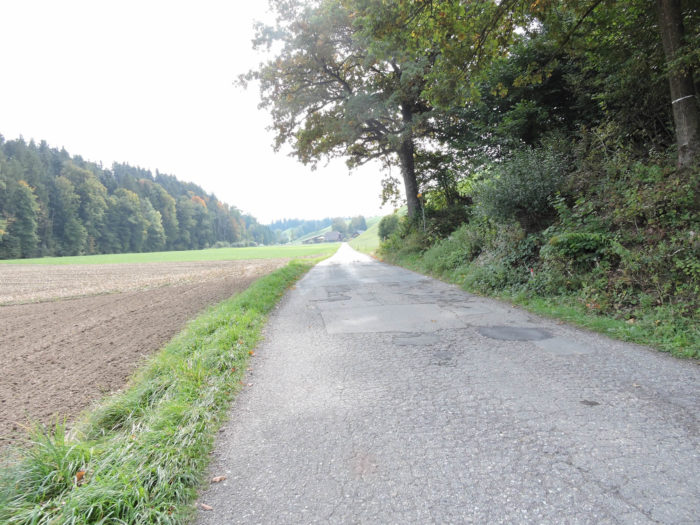 |
 |
| In these regions where cows seem to outnumber the inhabitants, and where grass remains their feast, it is customary to juggle between opening and closing electric fences. And when these are lacking, it is necessary to cleverly slip under the wires without experiencing an unpleasant electric shock. |
 |
 |
Section 7: Between the cantons of Luzern and Bern

General overview of route’s challenges: very hilly route, often with serious slopes.

| At the top of the climb, the path reaches Ufhusen, a village still located in the canton of Luzern. Here, cows, goats, and sheep coexist peacefully, sharing space harmoniously. An intriguing peculiarity of goats is their tendency to assert their superiority by positioning themselves on an elevation whenever they are in a group, a behavior shared with cats and sometimes even politicians. |
 |
 |
A church adorned with a baroque bell tower overlooks the village, with a crucifixion scene in front, offering a view filled with spirituality and tradition.

| Ufhusen stands out for its relative modernity, contrasting with the more traditional villages traversed in the past few days. |
 |
 |
| The contemporary houses, although practical, cannot compete with the timeless charm of homes from another era. These modern, mundane houses will never be beautiful in the future. |
 |
 |
| Further down, a road descends from Ufhusen to join a dale. In this region, livestock farming is the norm, and cultivated fields are quite rare, except for corn. |
 |
 |
At the bottom of this dale once lay the border between two notoriously rival cantons, Bern and Luzern. The disappearance of tolls between the cantons dates back only to 1848, the year of the formation of the Swiss federal state, marking a significant milestone in the history of the Swiss Confederation.

| Just beyond the border, a trail climbs through the grasses along the deciduous forest of Chilchwädli, but only for a short duration. In the distance, the hamlet of Feldmatt comes into view. |
 |
 |
| A path winding through the meadows towards the hamlet seemed to be the intended route. However, local farmers expressed their reluctance to see walkers wandering through their fields. Thus, the designers of the Via Jacobi created an alternative route, sometimes along the forest, sometimes within it, passing by small dry streams. |
 |
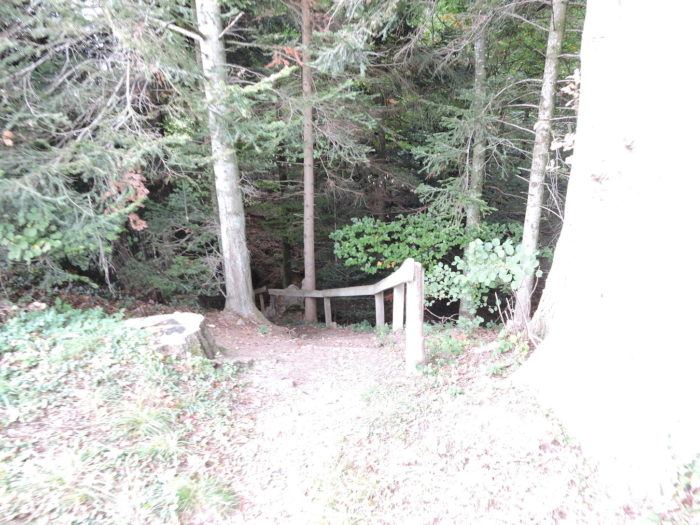 |
| However, at some point, the farmers may have agreed to let the path cross their lands to join the road passing through the hamlet of Neuhof/Feldmatt, about an hour’s walk from Huttwil. |
 |
 |
| From Neuhof, the Via Jacobi takes a paved road that leads to the forest. |
 |
 |
| After crossing this brief small wood, the faintly traced path emerges into the meadows. |
 |
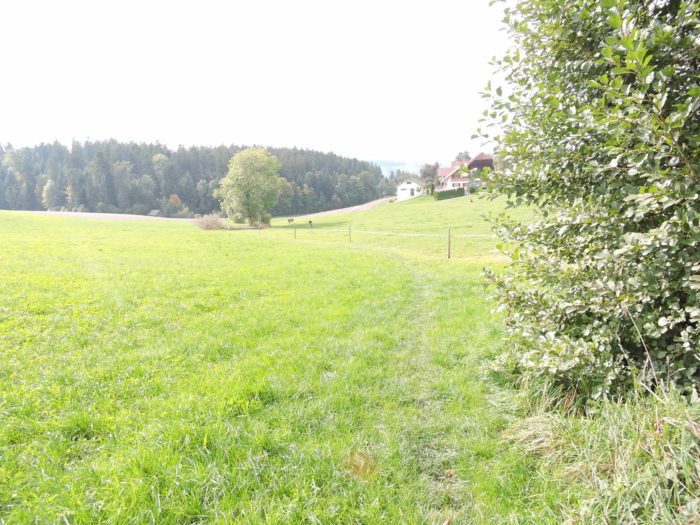 |
| Winding through these vast grassy expanses, it skirts the hamlet of Raberhof before once again heading toward the forest. This alternating pattern of forests, meadows, villages, and hamlets is characteristic of the Camino de Santiago in German-speaking Switzerland, offering breathtaking landscapes reminiscent of classic Swiss postcard scenes. |
 |
 |
| The Via Jacobi then crosses the last forest of the day, the Chammerewald forest, located near Huttwil, which is not the most beautiful forest on the route. |
 |
 |
| The forest features a Vita trail that runs alongside the path. These health trails, developed about fifty years ago by Swiss insurance companies on the outskirts of cities, are now less frequented, with only a few weekend joggers still running there, often ignoring the proposed exercises. |
 |
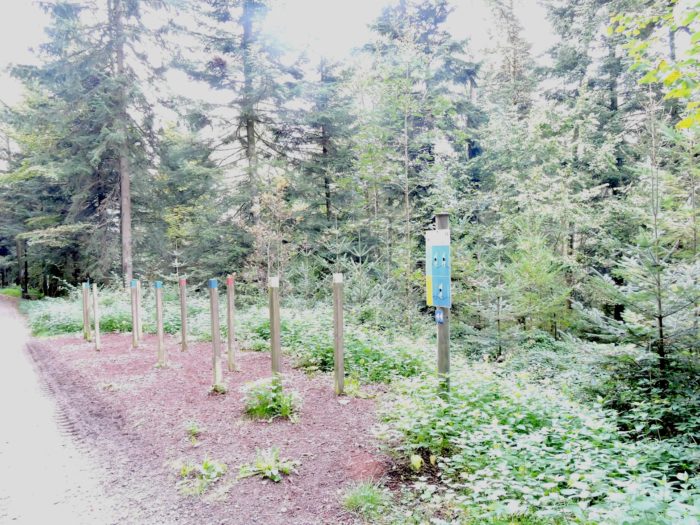 |
| On the other side of the forest lies the industrial area of Rüttistalden, where woodworking remains a priority. |
 |
 |
The Via Jacobi takes a small road and reaches the outskirts of Huttwil, at Rüttistalden.
|
 |
 |
Section 8: In Huttwil, a small town in Bern canton

General overview of route’s challenges: no difficulties.

| The descent of the Via Jacobi towards Huttwil gradually reveals the contrast between agricultural tradition and increasing urbanization. On the outskirts, the vast expanses of cultivated land and picturesque farms testify to the importance of agriculture in this region. However, this pastoral scene is increasingly interwoven with more conventional dwellings, illustrating the demographic and economic evolution of the small town. |
 |
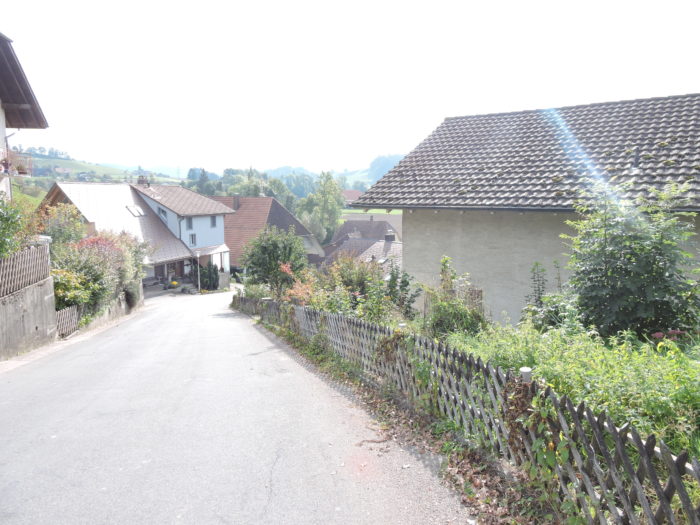 |
| As the road approaches the town, the soothing murmur of the Langete stream accompanies the pilgrims’ steps. |
 |
 |
| Soon, the familiar outlines of the church emerge on the horizon, marking the entrance into the historic heart of Huttwil. |
 |
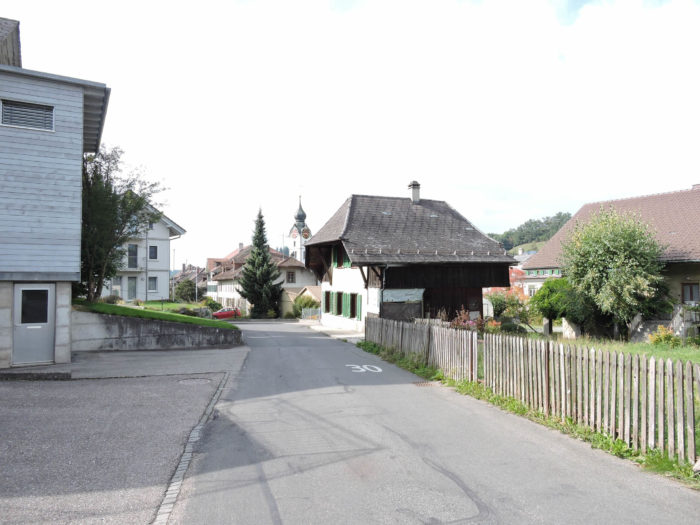 |
| Huttwil, with its 5,000 inhabitants, offers a tranquil refuge in the Upper Aargau region. Rooted in the Protestant tradition of the canton of Bern, the town exudes calm and authenticity. |
 |
 |
Accommodation on Via Jacobi
- Gasthaus Lamm, Hauptstrasse, Menznau; 041 493 11 32; Hotel, dinner, breakfast
- B&B Morf-Frei, Sonnengrund 5B, Willisau; 041 970 08 46/079 581 90 41; Guestroom, breakfast
- B&B Peter and Paul, Wydernatt 8, Willisau; 041 970 17 17; Guestroom, breakfast
- Gasthaus Post, Lauenplatz 3, Willisau; 041 490 25 06; Hotel, dinner, breakfast
- Gasthof Zum Mohren, Mohrenplatz 1, Willisau; 041 490 11 10; Hotel, dinner, breakfast
- Landwirt Fritz Mathys, Flurweg 10A, Huttwil; 062 962 12 34; Gîte (straw), breakfast
- B&B Lisa Neuenschwander, Rotbachstrasse 18, Huttwil; 062 962 38 87/079 726 55 32; Guestroom, breakfast
- Silvia und Martin Eicher – Waldkinder, Nyffenegg 1, Huttwil; 076 422 09 08; Guestroom, breakfast
- B&B De Heimelig, Nyffel 27, Huttwil; 078 633 49 30; Guestroom, breakfast
- Hotel Bahnhof, Bahnhofstrasse 41, Huttwil; 062 962 21 09; Hotel, dinner, breakfast
- Hotel Gute Hirt, Marktgasse 5, Huttwil; 062 962 20 10; Hotel, dinner, breakfast
- Hotel Restaurant Ochsen, Bahnhofstrasse 36, Huttwil; 061 706 52 00; Hotel, dinner, breakfast
At this stage, finding accommodation is hardly a challenge. Due to the length of the journey, some pilgrims prefer to split their trip into two, making a stop in Willisau. Both Willisau and Huttwil stand as modest towns, offering all the necessary shops. Between these two points, along the way, there are no supermarkets or restaurants for a comforting break. As is often the case in Switzerland, hotels set the standard for tourism.
Feel free to add comments. This is often how you move up the Google hierarchy, and how more pilgrims will have access to the site.
|
 |
Next stage : Stage 12: From Huttwil to Burgdorf |
|
 |
Back to menu |

























